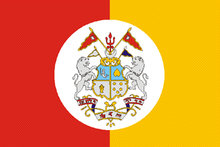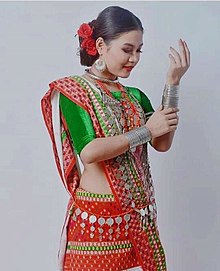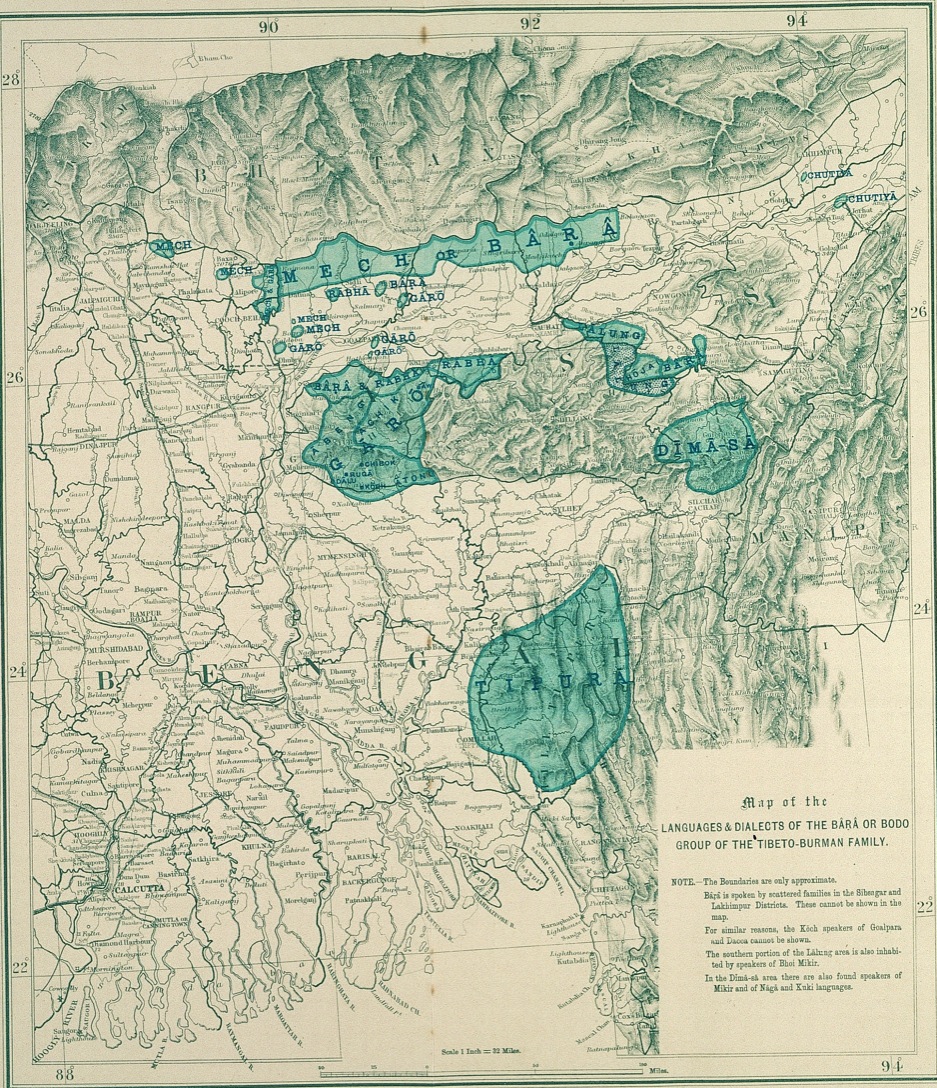Tripuri people
 Royal Flag of Tripura | |
 Tripuri girl in traditional attire | |
| Total population | |
|---|---|
| 1.2 million (2011) | |
| Regions with significant populations | |
| 1,011,294[1] | |
| Tripura | 950,875[1] |
| Mizoram | 32,634[1] |
| Assam | 22,890[1] |
| Meghalaya | 2,735[1] |
| Nagaland | 350[1] |
| Gujarat | 239[1] |
| Manipur | 208[1] |
| Jammu and Kashmir | 190[1] |
| Rajasthan | 169[1] |
| West Bengal | 120[1] |
| Maharashtra | 118[1] |
| Karnataka | 114[1] |
| 156,578 (2021)[2] | |
| Unknown | |
| Languages | |
| Kokborok (Tripuri) | |
| Religion | |
| Majority: Hinduism Minority: Christianity, Islam and Buddhism | |
| Related ethnic groups | |
The Tripuri (also known as Tipra, Tiprasa, Twipra) are an ethnic group originating in the Indian state of Tripura. They are the inhabitants of the Twipra/Tripura Kingdom in North-East India and Bangladesh. The Tripuri people through the Manikya dynasty[3] ruled the Kingdom of Tripura for many years until the kingdom joined the Indian Union on 15 October 1949.
History

Tripuris are the native people of Tripura having its own unique and distinct rich culture, tradition, and history. They were able to expand their influence as far south as Chittagong Division, as far west as Comilla and Noakhali (known during the British period as 'plains Tipperah')and as far north as Sylhet Division (all in present Bangladesh). Chittagong Hill Tracts was the part of Tipperah Kingdom till British took control of the Indian subcontinent. In the year 1512, the Tipperas were at the height of their supremacy when they defeated the Mughals. The ruling dynasty passed through several periods of history and ruled Tripura for several centuries until the 18th century, after which Plain Tippera became a colony of Britain and Hill Tippera remained an Independent Princely state. On 14 October 1949, Hill Tippera was merged into the newly independent India as Tripura State.
Language
The Tripuri people speak Kokborok (also known as Tripuri), a Tibeto-Burman language. Tripuri is the official language of Tripura, India. There are estimated to be more than one million speakers of the dialects of Tripuri in Tripura, and additional speakers in Mizoram and Assam in India, as well as Sylhet and the Chittagong Hill Tracts in Bangladesh. It is also spoken in Feni.
There are three main dialects of Tripuri, though the central dialect of the royal family, Debbarma (Puratan Tripur), is a prestige dialect understood by everyone. It is the standard for teaching and literature. It is taught as the medium of instruction up to class fifth and as subject up to graduate level.
Historically, Tripuri was written in native Tripuri script known as Koloma, the earliest known writing in Tripuri dates from the 1st century AD, and was written in Koloma. The script was replaced by an alphabet based on the Eastern Nagari script. Currently the revival of ancient Koloma script is in process.
Some of the most notable Tripuri historical literary works, written by court scholars, include:
- The "Rajratnakar", The royal Chronicle of Tripuri kings
- The Rajmala, Chronicle of Tripuri Kings of Tripura
Religion
According to the 2011 census, 93.6% of the Tripuri people follow an admixture of Hindu and folk religions; 6.4% of the Tripuri people are Christians (mostly, Baptists). Tripuri Hinduism is a syncretic religion, melding traditional folk religion with Hindu elements, commonly found in northeastern India.[4] A minority of the Uchai clan in Tripuri are Buddhist.[5]
Kinship
During Manikya monarchy Tripuri community consists of mainly five clans, together known as "Pancha Tripuri". The five Tripuri clans are: Puratan Tripuri, Deshiya Tripuri, Jamatia, Reang and Noatia. But later the five clans split into nine.
The main Tripuri clans are:
- Debbarma (Puratan Tripuri - Royal clan)
- Tripura
- Jamatia
- Reang or Bru
- Noatia
- Koloi
- Murasing
- Rupini
- Uchoi/Usoi
Society

The Tripuri people consist of clans, each with its own elementary social and administrative organisation starting from the village level and up to the chieftainship of the whole community.[6]


These indigenous communities enjoy their traditional freedom based on the concept of self-determination. The relation between the king and the subject communities was as Maharaja (king) of Tripura-Missip or liaison officer Roy or headman of the community – Sardar the chief of the village – the individual. Earlier, only the Debbarma or Tipra ethnic group was included in the Tripuri Kshatriya group. Later, the Raja included other groups like Reang, Jamatia and Noatia as well, in an attempt to foster a sense of kindness among the people under his region.[7]
The Tripuri people have a rich historical, social, and cultural heritage which is totally distinct from that of the mainland Indians. Their distinctive culture – as reflected in their dance, music, festivals, management of community affairs, dress and food habits – has a strong base. Kokborok, the lingua franca of the 12 largest linguistic groups of the indigenous Tripuris and other dialects spoken in Tripura are of the Tibeto-Burman group and distinct from those spoken in India. There is no influence from those spoken by other peoples in the north-eastern region.
Calendar
The Tripuris follow a traditional luni-solar calendar Tripurabda, which has 12 months and a 7-day week, like the Gregorian calendar.
The Tripura Era's New Year is on the 1st of Vaishakh which corresponds to 14 or 15 of April of Common_Era, depending on whether that year is a Leap year or not. The months are named in pan Indian months, time since its inception 1419 years back by Tripuri king Hamtor pha alias Himti pha alias Jujharu pha in 512 Saka Era.
Tripuri games and sports

Like many parts of the world the Tripuri has traditional sports. It is common in almost all the clans of Tripuri. They are called thwngmung in Tripuri.
Notable people
Bangladeshi
- Sushanto Tripura, defender for the Bangladesh national football team
- Shobha Rani Tripura, Ekushey Padak recipient
- Jotindra Lal Tripura
- Kujendra Lal Tripura Politician , MP (Member of Parliament 299 Constituency)Khagrachari Hill District.
- Naba Bikram Kishore Tripura
Indian
- Bir Bikram Kishore Debbarman – 1908–1947, one of the last Kings of Tripura.
- Sachin Dev Burman – Bollywood composer and singer.
- Rahul Dev Burman – Bollywood composer and singer.
- Kirit Bikram Kishore Deb Barman
- Pradyot Bikram Manikya Deb Barma Titular King and Current Head of Tripura Royal Family
- Bibhu Kumari Devi – Rajmata of Tripura
- Kanchan Prava Devi
- Radha Kishore Manikya
- Birendra Kishore Manikya
- Maha Manikya
- Dharma Manikya I
- Ratna Manikya I
- Nabadwipchandra Dev Burman– Indian sitarist and Dhrupad singer
- Pratap Manikya
- Sourabhee Debbarma – First female Indian idol winner, TV performer and singer.
- Riya Sen Dev Varma – Bollywood actress.
- Raima Sen Dev Varma – Bollywood actress.
- Somdev Devvarman – Indian tennis player.[8][9][10][11]
- Narendra Chandra Debbarma
- Jishnu Dev Varma Politician,Deputy CM of Tripura.
- Dasarath Deb
- Aghore Debbarma
- Jitendra Chaudhury
- Rebati Tripura Politician.
- Sudhanwa Debbarma
- Bidya Debbarma
- Ranjit Debbarma
- Nagendra Jamatia
- Benichandra Jamatia – Padma Shri Indian folk writer and litterateur
- Mevar Kumar Jamatia Former Minister of Tribal Welfare and Forest, Tripura.
- Satyaram Reang – Padma Shri Indian folk performer and folk artist
- Harinath Debbarma
- Tanushree Deb Barma, The First Woman IAS Officer of Tripura.
- Nanda Kumar Deb Barma
- Manoranjan Debbarma Politician.
- Rashiram Debbarma
- Aghore Debbarma
- Padma Kumar Debbarma
- Jashabir Tripura
- Ramendra Narayan Debbarma
- Radhacharan Debbarma
See also
- Tipraland
- Tripuri culture
- Kokborok literature
- Tripuri nationalism
- Manikya Dynasty
- Tripuri calendar
- Tripura rebellion
- Buisu
- Ujjayanta Palace
- Neer Mahal
References
- ^ a b c d e f g h i j k l m "Distribution of the 99 Non-Scheduled Languages- India/ States/ Union Territories-2011 Census" (PDF). censusindia.gov.in. pp. 48, 49. Retrieved 10 April 2021.
Look for "92. TRIPURI", total number of Tripuri speakers in India given as 11294 on page 48, then state wise break-up on page 49
- ^ "Table 1.4 Ethnic Population by Group and Sex" (PDF) (in Bengali). Bangladesh Bureau of Statistics. 2021. p. 33.
- ^ Jain, Anshika (11 June 2019). "Tripura's Ujjayanta: Seat of the Manikyas". Live History India. It rose like a phoenix out of the ashes, quite literally. Situated in the city of Agartala is the exquisite Ujjayanta Palace, home of the Tripura royals and also a state museum. This delicate beauty was built in the late 19th century by Maharaja Radha Kishore Manikya of the Manikya dynasty, after a devastating earthquake flattened Agartala, the capital of Tripura. It went on to become a symbol of a modern phase in the Kingdom of Tripura. You may not have heard of them but the Manikya dynasty of Tripura is one of the oldest continuously reigning dynasties of India. The exact date of its founding is shrouded in legend – the Rajmala, a 15th century chronicle of the kings of Tripura, traces the history of the dynasty to the Mahabharata. But, historically speaking, the dynasty is said to have been founded by Ratna Manikya in 1267 CE. Archived from the original on 29 September 2020. Retrieved 3 April 2021.
- ^ "Tripura" (PDF). Office of the Registrar General & Census Commissioner, India.
- ^ "Buddhist monk from Tripura elected secretary general of the International Buddhist Confederation". Retrieved 9 August 2021.
- ^ "Tripuri community has started reviving its traditional bodies in Tripura". www.sentinelassam.com. 19 March 2020. Retrieved 30 January 2021.
- ^ Asian Studies, Volume 4 by Netaji Institute for Asian Studies, p.4
- ^ "Asiad: Somdev Creates History, India Retains 8th Spot". Outlook. 23 November 2010. Retrieved 13 April 2021.
- ^ "Somdev receives Arjuna Award". Hindustan Times. 20 September 2011. Retrieved 13 April 2021.
- ^ Agencies, New Delhi (20 September 2011). "Somdev Devvarman receives Arjuna Award". The Indian Express. Retrieved 14 April 2021.
- ^ "Kidambi Srikanth, Somdev Devvarman receive Padma Shri awards; Padma Bhushan for Dhoni". The Times of India. Retrieved 13 April 2021.



